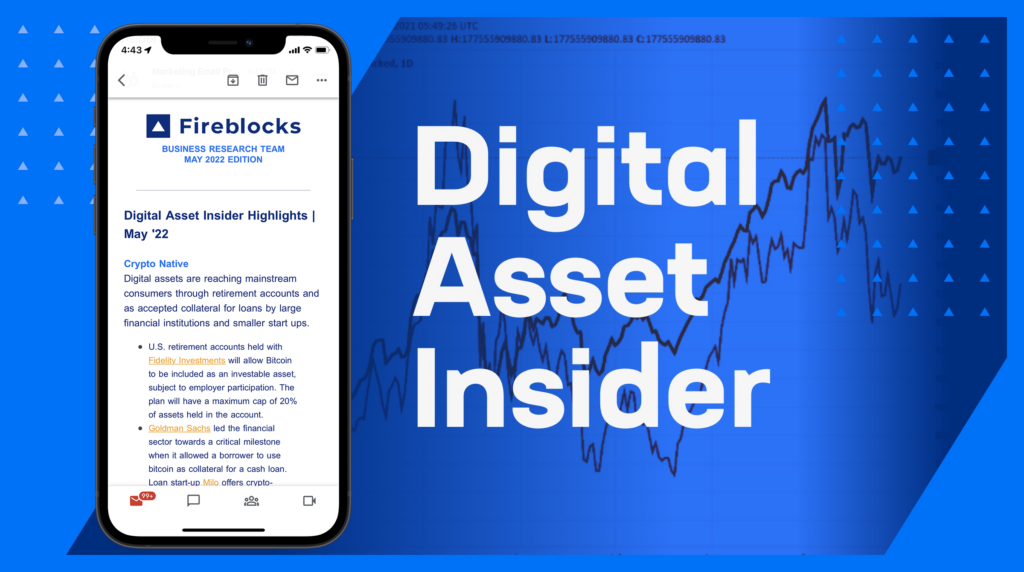This past month, we saw digital assets go mainstream with well known financial institutions, who are starting to make them more accessible as investments and for loans. The start of the second quarter saw digital asset markets taper off back towards March lows. Institutional DeFi adoption has also continued to grow in April, with Fireblocks expanding that access with new support for DeFi protocols, including DeFi on Terra, Moonbeam, and XDC. We are also really excited about our new FIS partnership, which will make it easier for TradFi firms to adopt digital assets quickly and securely.
Crypto Native
Digital assets are reaching mainstream consumers through retirement accounts and as accepted collateral for loans by large financial institutions and smaller start ups. A financial institution behind a spot-based exchange traded fund (ETF) has challenged the United States Securities and Exchange Commission in their rationale for denying spot-based bitcoin ETFs but approving futures-based bitcoin ETFs. Meanwhile, numerous cryptocurrency ETFs in Australia are in the process of being launched despite technical delays.
- U.S. retirement accounts held with Fidelity Investments will allow Bitcoin to be included as an investable asset, subject to employer participation. The plan will have a maximum cap of 20% of assets held in the account.
- Goldman Sachs led the financial sector towards a critical milestone when it allowed a borrower to use bitcoin as collateral for a cash loan. This initial step in accepting a cryptocurrency for use as collateral could pave the way for more institutions to consider following, and offer other types of loans based on digital assets.
- At the smaller end of the market, loan start-up Milo offers crypto-holders access to 30-year mortgages in the United States using Bitcoin, Ethereum or stablecoins as loan collateral. While Milo retains the house as traditional collateral, the crypto-based collateral serves an alternative route before foreclosure in the event of a payment default.
- Grayscale is seeking to have their spot-based exchange traded fund (ETF) approved by the United States Securities and Exchange Commission (SEC), after the SEC approved another bitcoin futures-based ETF by Teucrium. Grayscale’s lawyers argued that Chicago Mercantile Exchange (CME) Bitcoin futures are priced based on spot Bitcoin markets and therefore directly influenced by them. The SEC should therefore be comfortable with both types of ETFs.
- Three Australian exchange traded funds (ETFs), which were expected to be launched in April on the Cboe Exchange, have faced delays due to issues at a downstream service provider. ETF Securities had planned to launch a spot-based Bitcoin ETF and a spot-based Ethereum ETF, while Cosmos Asset Management was prepared to launch the Cosmos Purpose Bitcoin Access ETF. Three additional ETF applications are pending approval submitted by VanEck Australia Pty Ltd., BetaShares Capital Ltd., and Monochrome Asset Management Pty. Ltd.
Tokenization
From investment banking to asset management, financial institutions across the board are showing greater interest in tokenization using various token standards, including using non-fungible tokens (NFTs) as a certificate of ownership on a blockchain protocol. Tokenization on both permissioned and public blockchain protocols is also being explored, highlighting the importance of the interoperability of digital asset infrastructure to reduce friction and transaction costs at this early stage.
- Blackrock announced its interest in asset tokenization and permissioned blockchains. Blackrock has indirect exposure to cryptocurrencies through its investments into companies such as MicroStrategy, which directly holds bitcoin. They also have two funds (BlackRock Strategic Income Opportunities and BlackRock Global Allocation Fund Inc.) that have exposure to cryptocurrencies through regulated bitcoin exchange-traded futures.
- Goldman Sachs is reported to be exploring tokenization of real assets through the use of non-fungible tokens (NFTs). Last November, the investment bank announced it was partnering with Digital Assets to develop their own digital asset infrastructure. They expect the infrastructure to support digital asset transactions across multiple asset classes on both permissioned and public blockchain protocols.
Regulation | Regulators
Financial regulators are calling for more dialogue with crypto firms to bring them under the regulatory umbrella. Global regulation coordination is needed to reduce regulatory arbitrage, formulate a consistent definition of what constitutes a digital asset, and determine how digital asset use cases will be recognized in their various forms.
- The United States Securities and Exchange Commision (SEC) Chair Gary Gensler is looking to work with crypto platforms to get them “registered and regulated to best ensure the protection of customers’ assets” and determine “whether it would be appropriate to segregate out custody”. Earlier in the month, the SEC provided guidance for companies in the United States acting as custodians of cryptocurrencies to account for them as liabilities and disclose associated risks to investors.
- An executive board member of the European Central Bank (ECB) Fabio Panetta, has called for globally coordinated efforts to regulate crypto to the same, if not higher, standards as traditional finance. Panetta cited that the size of the crypto market ( $1.3 trillion) is now larger than the subprime mortgage market that led to the Global Financial Crisis in 2008.
- The Oman Capital Markets Authority (OCMA) is looking to incorporate real estate tokenization into their virtual asset regulatory framework. This will allow for the issuance of virtual assets, and in the case of real estate tokens, provide investment opportunities for local and foreign investors in Oman’s real estate sector.
Payments | Settlement
As digital assets begin to be accepted as payments, two things must happen. First, corporate treasuries will need a secure custodial wallet. Second, corporate treasury leaders will need to be able to exchange cryptocurrencies held to fiat, and determine how best to hedge their cryptocurrency exposures, which could include derivative instruments like options and futures.
- A real-estate developer in Dubai, Damac Properties, plans to accept cryptocurrencies as payment for properties.
- The city authorities of Argentina’s capital, Buenos Aires, will accept crypto for its residents to pay city taxes. It is part of a wider plan to transform the city into a digitally focused one.
- In a crypto-B2B partnership, VeChain’s VET token will be accepted as payment through crypto payments platform Alchemy Pay, which has access to traditional payment platforms – Visa, Mastercard and Paypal – and therefore to their network of merchants.
- Luxury fitness club Equinox teamed up with BitPay to allow its members to pay their membership fees using crypto.
Decentralized Finance
Decentralized finance platforms are recognizing the need to incorporate compliance standards to reduce the exposure of their services being used by those involved in illicit activities. DeFi platforms have formed partnerships with credit provisioning firms that enable them to provide services that give them better access to the asset management industry.
- Decentralized exchange Uniswap has partnered with TRM Labs to scan for and block wallets linked to illicit activities. Authorities have been concerned that crypto trading venues have allowed funds to be moved related to sanctioned countries (or individuals), terrorist activities, human trafficking, or that have been stolen.
- Fireblocks announced their support for DeFi on Terra, officially becoming the first platform to provide institutional access to dApps on Terra. Customers have already leveraged this access – over $500 million of volume moved across the platform in its first week of availability.
- Uncollateralized lending platform Maple Finance, has launched on Solana with a $45 million pool making it a multi-chain lending platform. X-Margin is involved in providing credit related services and CoinShares as an asset manager.
- TRON is set to launch an algorithmic stablecoin, the USDD, tied to the U.S. Dollar. It will be available on two other blockchain protocols – Binance Smart Chain and Ethereum. The minting and burning mechanism will be similar to Terra’s UST stablecoin, where Tron’s TRX native token will act in the same way as Terra’s LUNA native token to regulate the one-to-one peg of USDD to the U.S. Dollar.
Centralized Finance
Centralized exchanges continue to set up a presence in favorable regulatory and business environments in the Middle East region. This could put competitive pressure on jurisdictions such as Switzerland and Singapore, who historically have been considered the most favorable markets for crypto-native firms.
- U.S.-based exchange Kraken is joining Binance and FTX in gaining a virtual asset service provider (VASP) license in the Middle East region, opting for Abu Dhabi instead of Dubai as their licensing country of choice. The countries forming the United Arab Emirates as a whole are focused on making their economies friendly to crypto-businesses and bring diversification away from oil and gas.
- Centralized finance firms are using bridging technologies to make their blockchain protocols interoperable with other protocols and expand their ecosystem. Binance’s Bridge 2.0 allows users to lock tokens on the originating protocol and create copies on the Binance BNB Chain. The process is reversed by burning the tokens on the BNB Chain and unlocking the original token. Blockchain (or network) bridges have their risks, as experienced by the Sky Mavis Ronin Network Bridge last month, where over $600 million worth of Ethereum and USDC tokens were hacked and lost.
Custody
Firms offering cryptocurrency services like custodial wallet services will be required to become licensed or register themselves with financial regulators in order to operate their businesses. We expect this trend to continue as more countries seek to manage their citizen’s exposure to and use of digital assets.
- Germany’s Commerzbank is the first bank to submit an application to the Federal Financial Supervisory Authority (BaFin) for the crypto custody license. Four companies have been granted the license – Coinbase Germany, Kapilendo Custodian, Tangany, and Upvest.
- In Belgium, the Financial Services and Market Authority (FSMA) has stated that companies looking to offer cryptocurrency services will have to register with the regulator in order to operate in the country. The cryptocurrency services include those around exchange and custodial wallets. In addition, a minimum capital requirement is being imposed of 50,000 euro by the FSMA.
CBDCs
Central banks globally have continued to conduct and report on project outcomes that have been underway for many months. There is no shortage of interest in working on wholesale focused CBDC projects that include research into the technology that supports CBDCs. The time horizons stated encompassing these initiatives are as soon as within 2022, or further out towards 2027-2028.
- Mexico’s Central Bank governor, Victoria Rodriguez, announced that a central bank digital currency (CBDC) could be expected to be launched by 2025. Meanwhile, the Brazilian Central Bank president confirmed that a CBDC pilot would launch in 2022 with a fixed supply of the digital real pegged against fiat real.
- The South African Reserve Bank (SARB) has completed the second phase of their wholesale-focused CBDC project which covered clearing, trading and settlement. Industry participants in this phase included financial services firms Absa Group, FirstRand, Nedbank Group, Standard Bank, and the Johannesburg Stock Exchange.
- Sweden’s central bank, Sveriges Riksbank, has sent out a request for information from technology suppliers related to the technical options for a digital krona. The central bank is exploring the technical options for use within five to six years.
- The Bank of England will collaborate with the Massachusetts Institute of Technology (MIT) on the research and development of a CBDC. The intention of the project is not aimed at formulating an operational CBDC, and will be twelve months in duration.
ESG Impact
For there to be an active market in carbon credit trading, there needs to be a greater number of participants who have access to the infrastructure that provides the liquidity to trade these markets. The trading infrastructure may come in the form of centralized or decentralized exchanges. Financial institutions have existing clients who have a need, if not a requirement, to meet carbon emission targets. They are increasingly looking for the right infrastructure providers to connect to, develop on, and green firms that have access to verifiable green projects that are not ‘greenwashed’.
- Algorand plans to implement a smart contract allowing network transaction fees to automatically purchase carbon credits on carbon credit marketplace ClimateTrade. The purchase of carbon credits is aligned with the protocols pledge to be carbon-negative. Cardano’s approach was to partner with Veritree where one tree is planted and tied to one token which is verified and serves as a certificate of ownership.
- Singapore’s OCBC Bank is partnering with MetaVerse Green Exchange (MVGX) to develop green financing solutions using tokenized carbon credits. Last month we highlighted MVGX’s tie up with real estate developer Greenland Group to trade carbon credits through Greenland’s Guizhou Green Finance and Emissions Exchange.
- Ocean-based “Blue” carbon credits are being considered by the Bahamas (worth at least $300 million) to be sold on the voluntary carbon markets. In the United States, local and state governments are looking at public-owned forests to be included in carbon projects. Meanwhile, companies are seeking listing on Canadian stock exchanges with plans to raise capital to finance carbon-credit purchases or invest in climate projects and generate credits.
Crypto-Native Market Analytics
Bitcoin, Ethereum, and most of the Altcoins retraced most if not all of the gains achieved in March. Net Exchange flows for Bitcoin were net outflows everyday in April, and indicative of how the markets were broadly seeing cryptocurrencies at the start of the second quarter. Total Market Capitalization fell below $2 trillion, and DeFi markets as represented by Total Value Locked remained over $200 billion. This could indicate some resilience and continued interest in DeFi protocols and dApps, and their ability in attracting capital (An example of which we observed with Fireblocks’ launch of its support for Terra).
CHART OF THE MONTH: U.S. Stablecoins
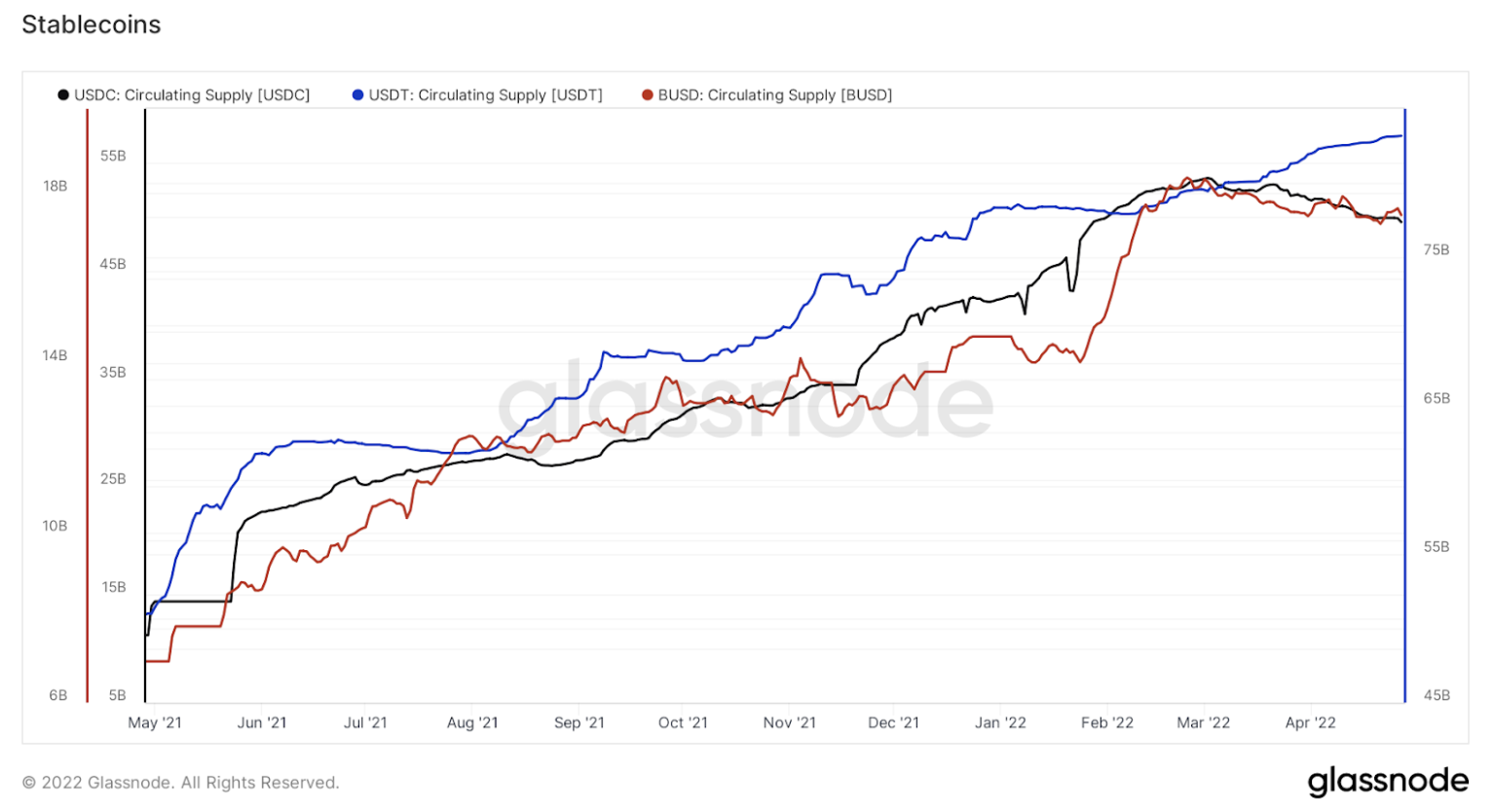
Stablecoin growth has steadily increased over the last 12 months as more users enter the digital asset markets, especially DeFi lending platforms tapping into the low volatility characteristics of stablecoins.
MONTHLY CHANGE
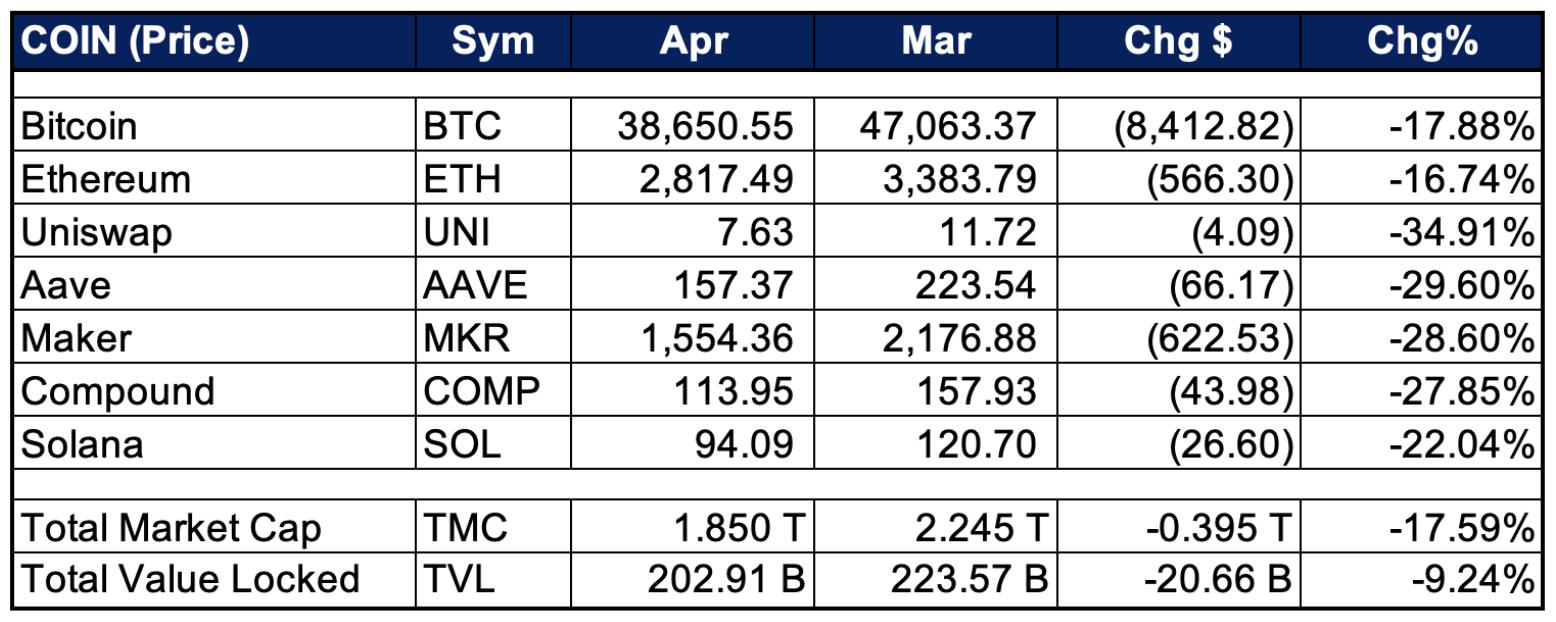
Altcoins broadly sold off over the month.
TOP 10 MARKET CAPITALIZATION
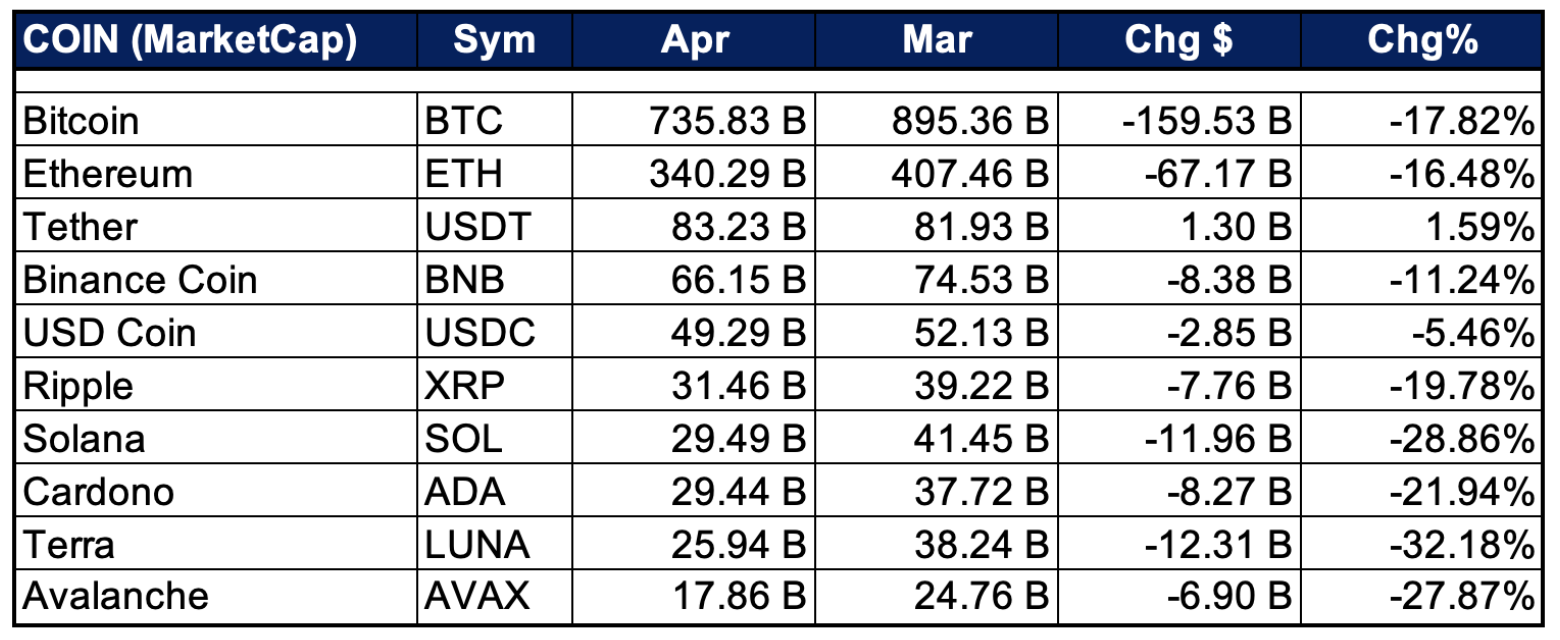
Digital asset markets took a breather in April.
BITCOIN [BTC]
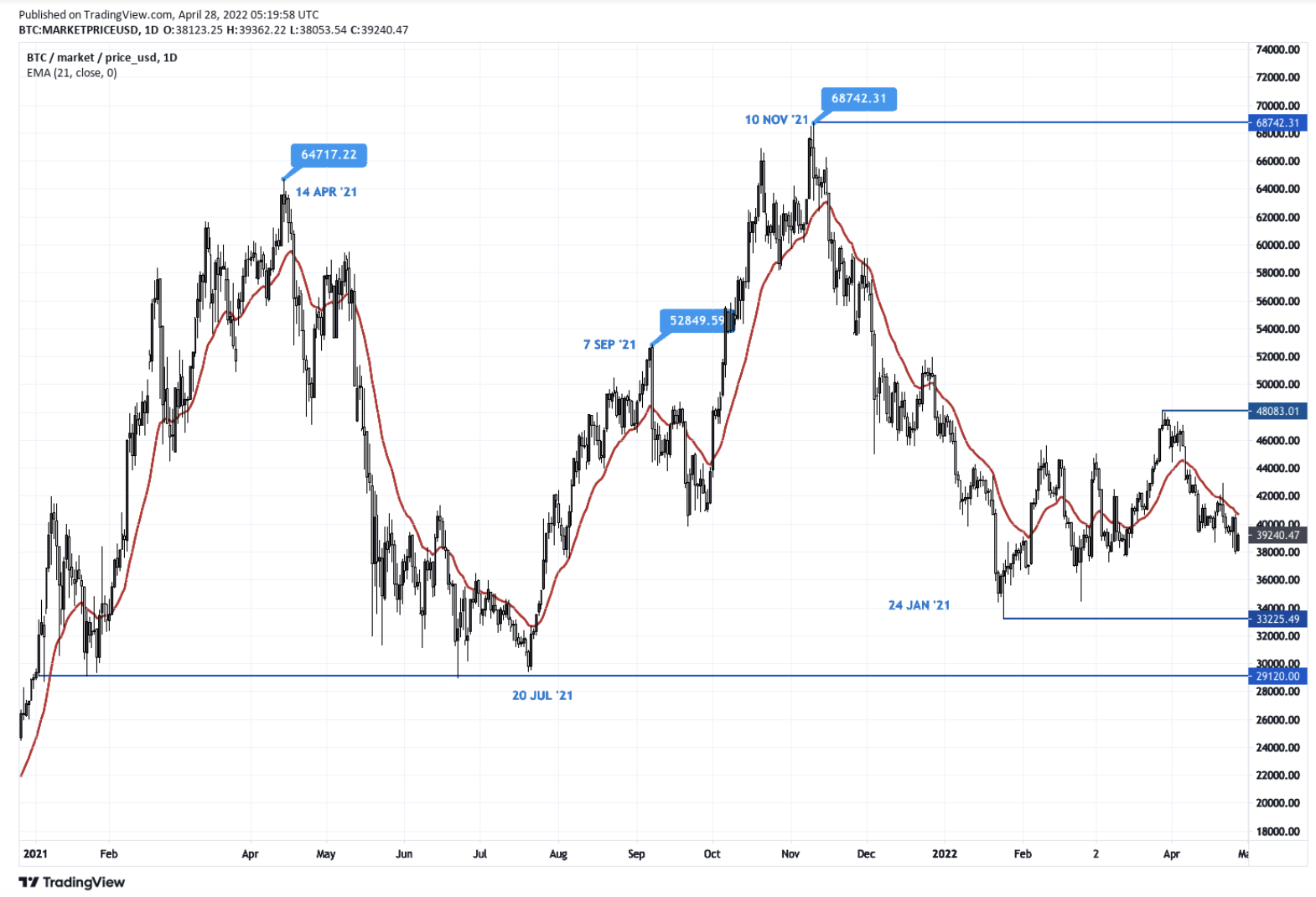
Bitcoin retraced towards the March lows around $38,000 and set $48,000 as a lower high acting as resistance. The higher low set on 24 Jan at $33,225 serves as a line in the sand for market participants bullish on Bitcoin. Failing which the $29,000 area will come into focus.
ETHEREUM [ETH]
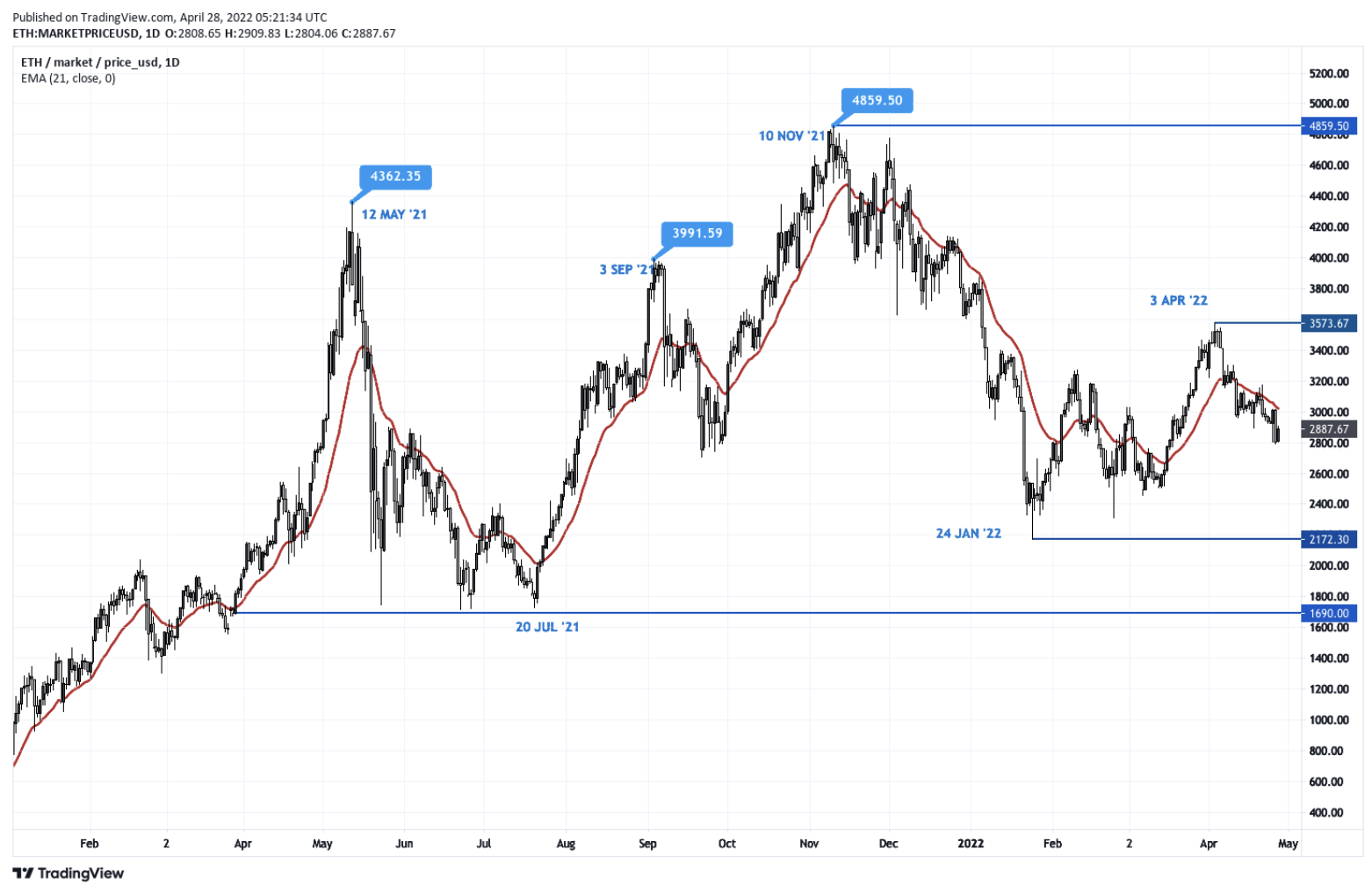
Ethereum will maintain a higher low if it holds above $2,600 going into May. A break of $2,172 could indicate further weakness ahead.
BITCOIN : STOCK TO FLOW RATIO [BTC:STFR]
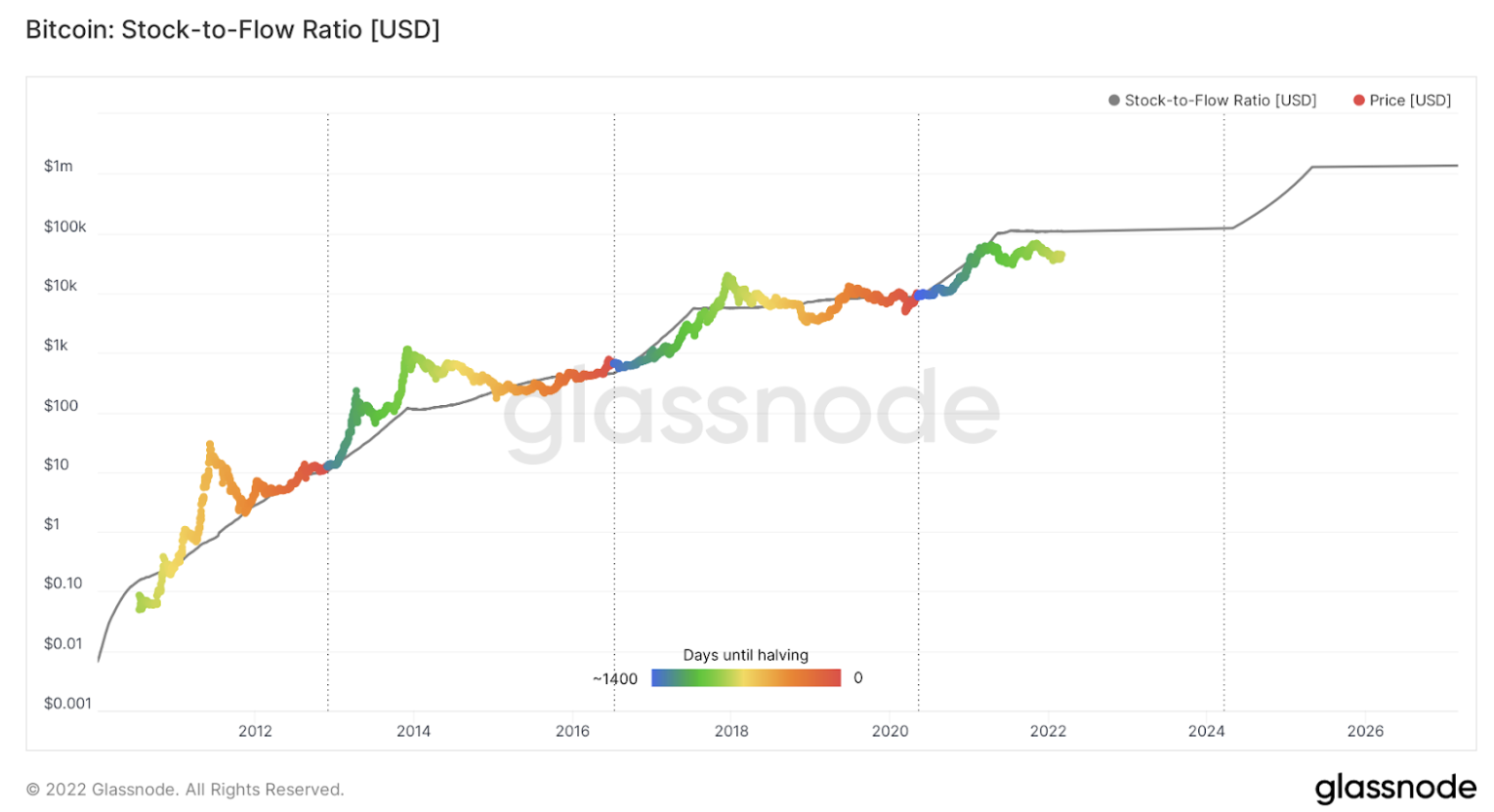
BTC is lower than STFR, indicating it is undervalued.
BTC: ALL EXCHANGES NETFLOW
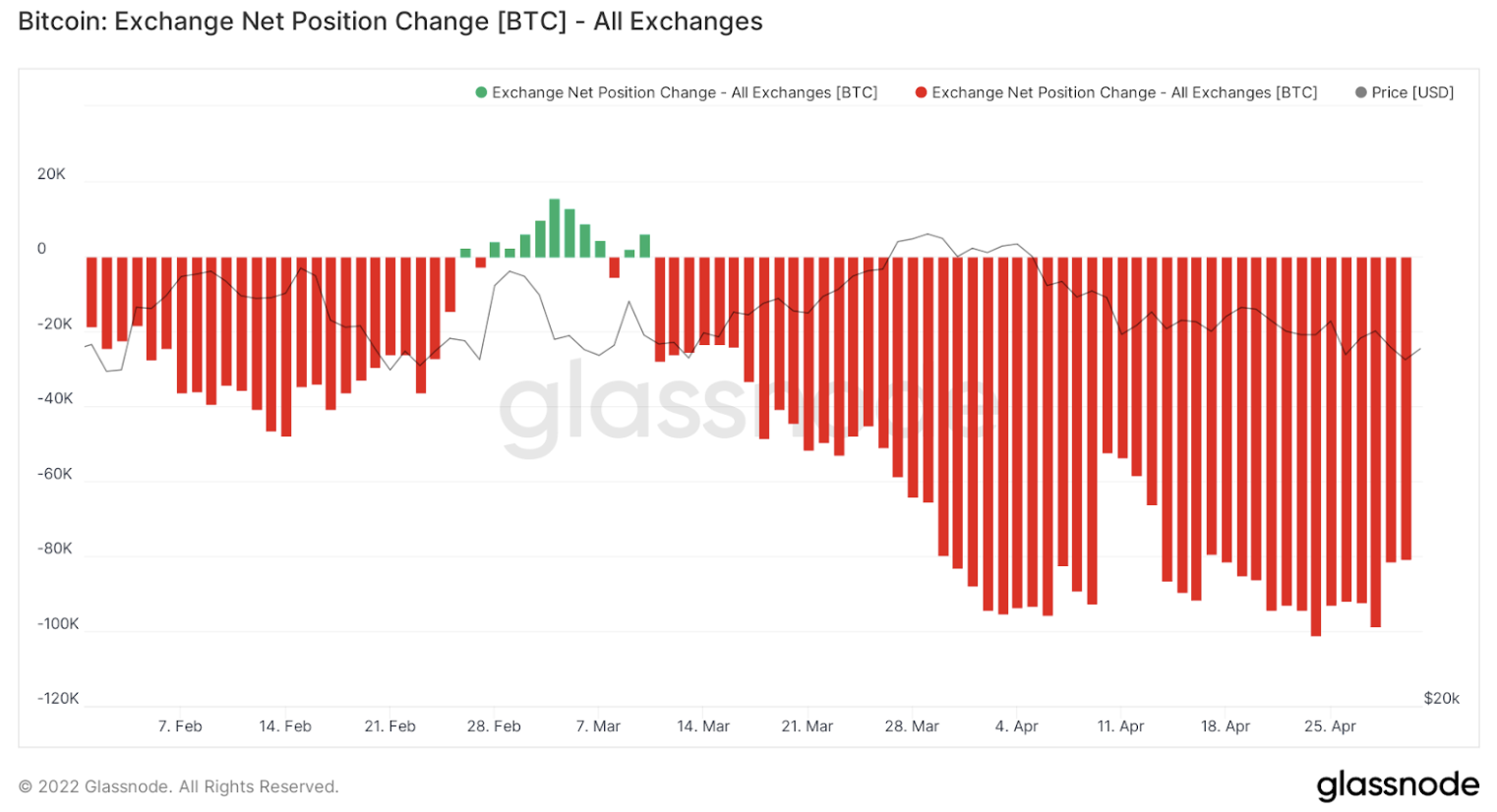
There were no days in April with net inflows into exchanges with BTC price falling.
REGIONAL BTC FLOWS [Last 7 Day Average, May 3]
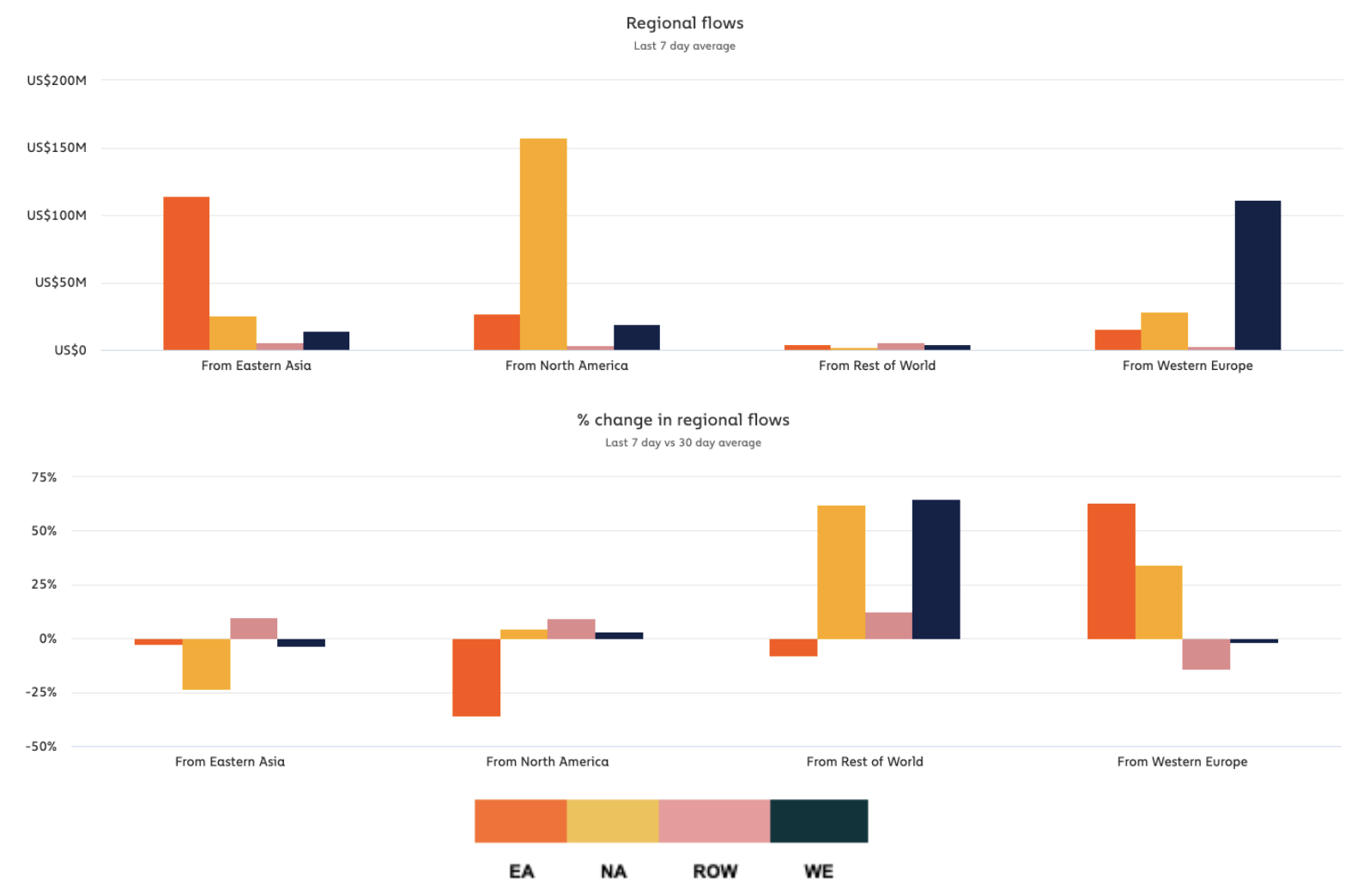
Regional flows have fallen back below $200 million and remained predominantly intra-regional.
Falls in flows from a percentage change perspective appeared between North America and East Asia.
Assets typically flow within a region, likely due to preferences for local exchanges, but flows between regions often occur as a result of regulatory concerns, geopolitical changes, or significant market price variations.
TOTAL VALUE LOCKED [TVL, April 30]
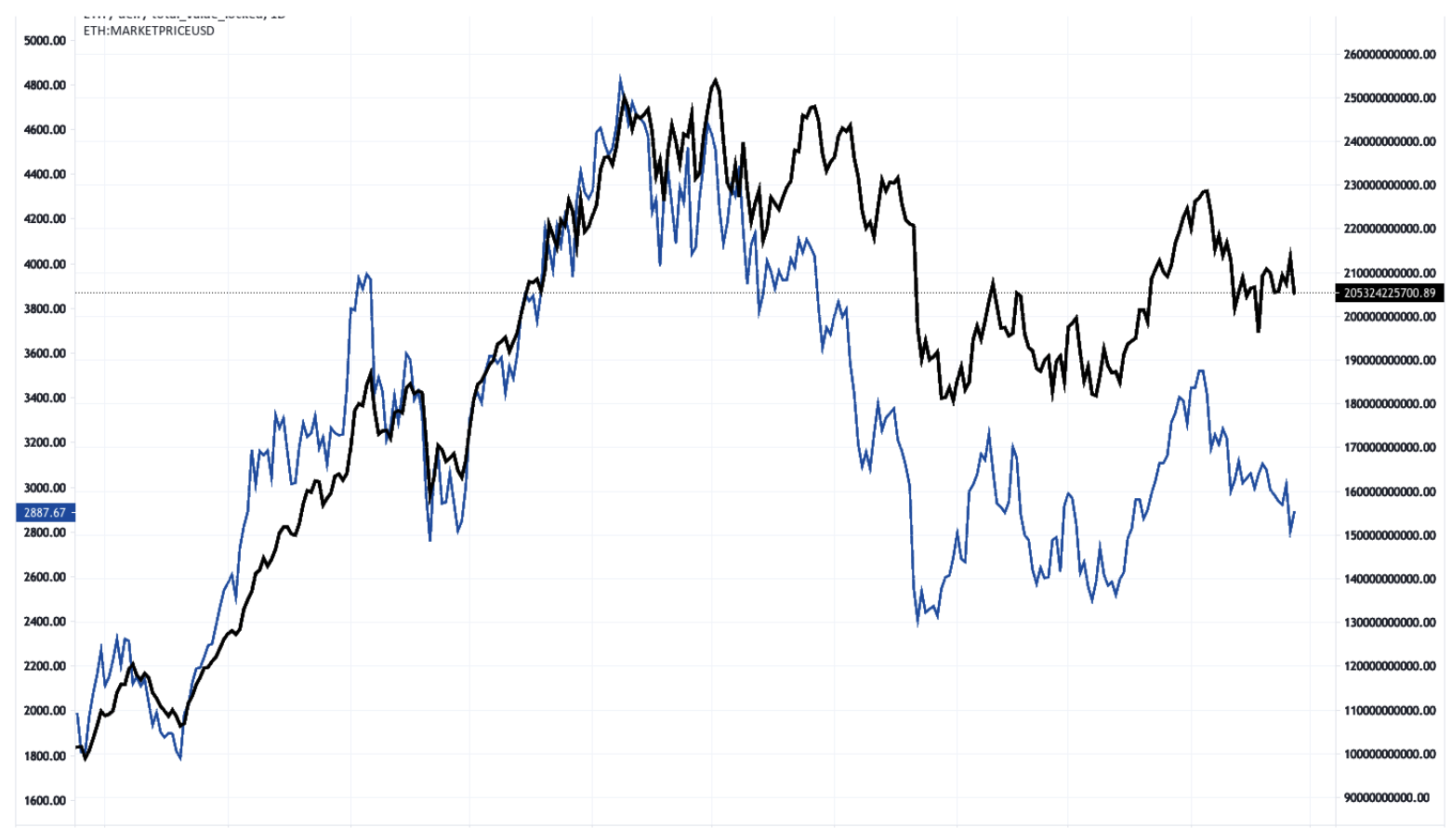
DeFi TVL fell along with the fall in ETH and Altcoin prices.
PROTOCOL POSITION [TVL, April 30]
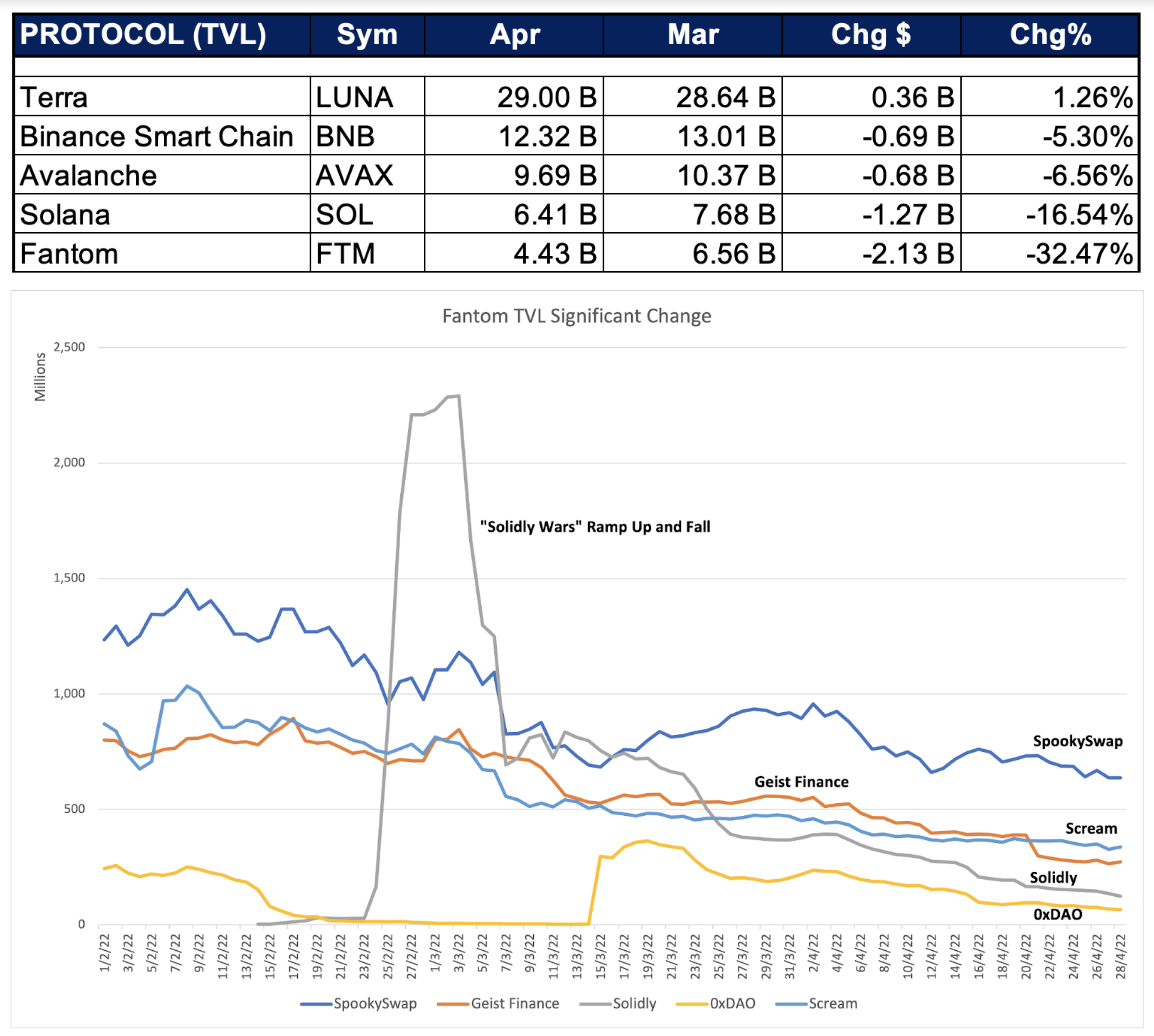
Total value locked (TVL) for Fantom has continued to slide towards the levels where FTM surged at the start of October 2021. The fall in TVL has been most notable intra-month in February where the Solidly dApp saw a surve in TVL as part of the “Solidly Wars” highlighted in March’s Digital Asset Insider. The outcome of this event and the departure of key Fantom “influencers” highlights the protocol risks market participants need to consider before investing.
DEFI PULSE INDEX [DPI]
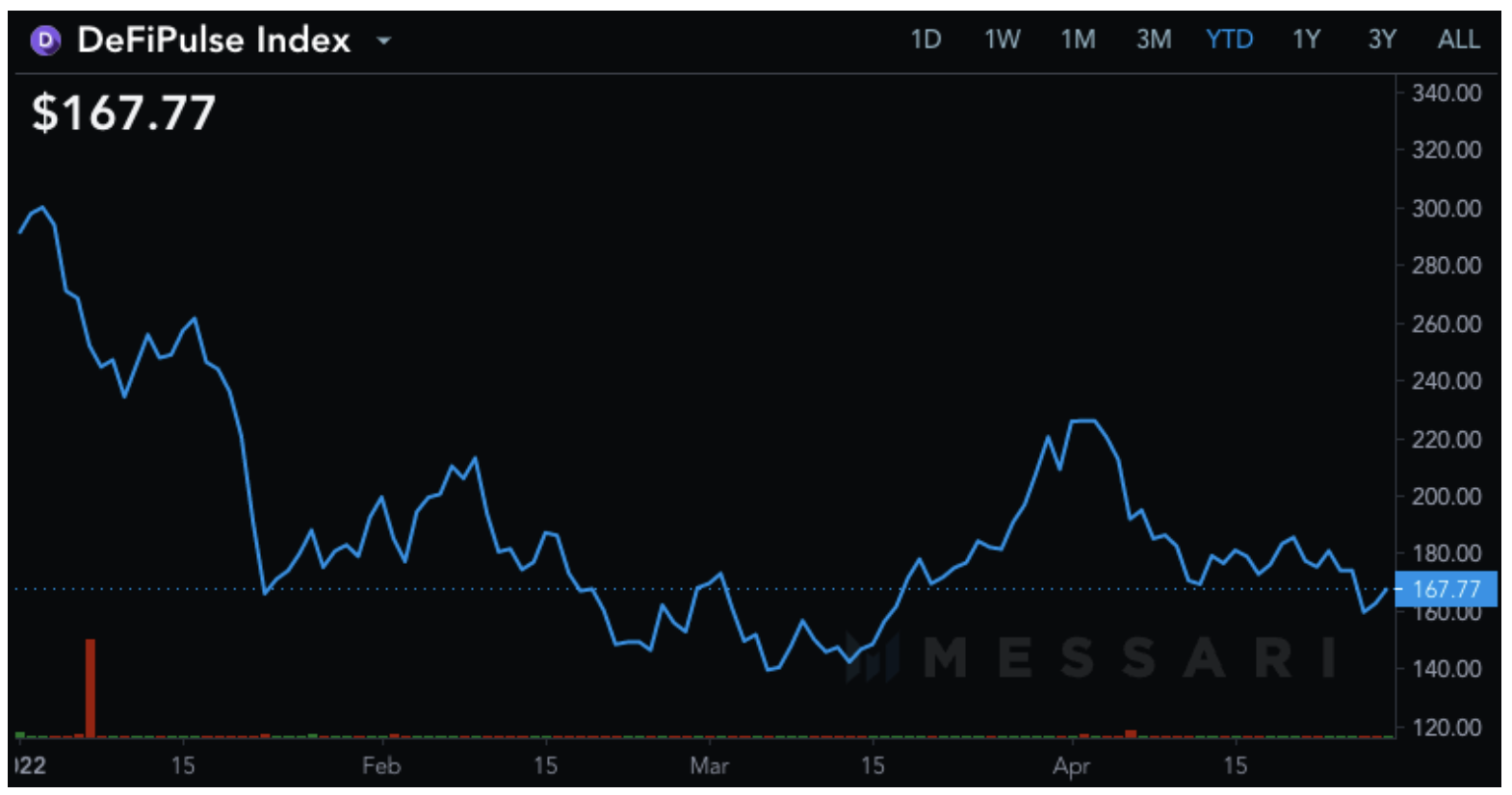
Top 5 Tokens: Uniswap, Aave, Maker, Loopring and Synthetix.
Index information can be found at the Tokensets.com.
This reCap is distributed for general informational and educational purposes only and is not intended to constitute legal, tax, accounting, or investment advice. For other important disclosures.



